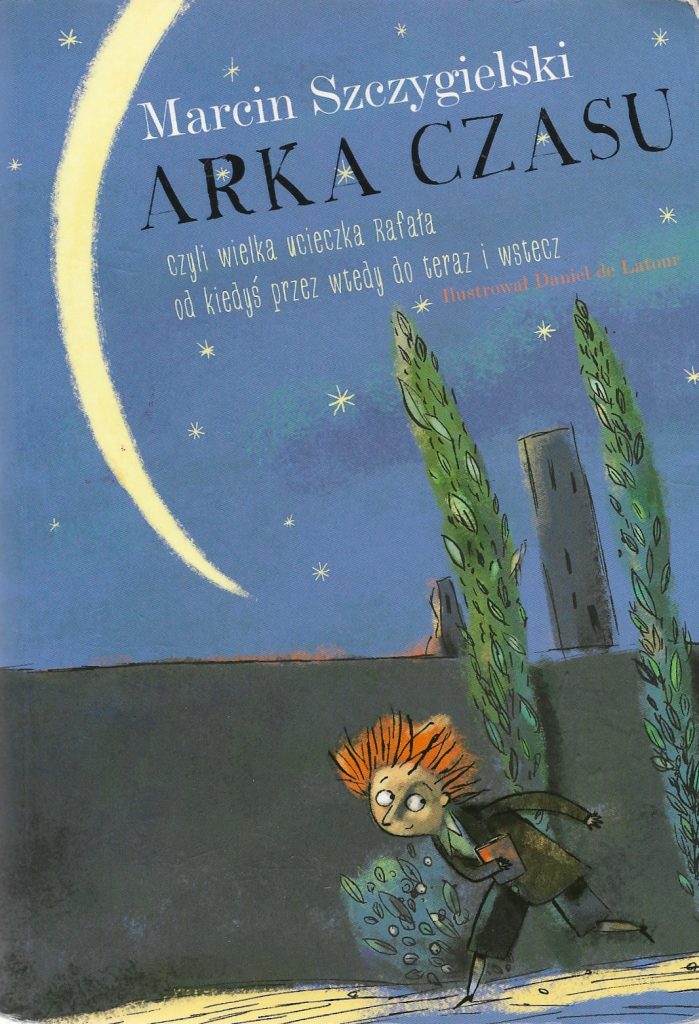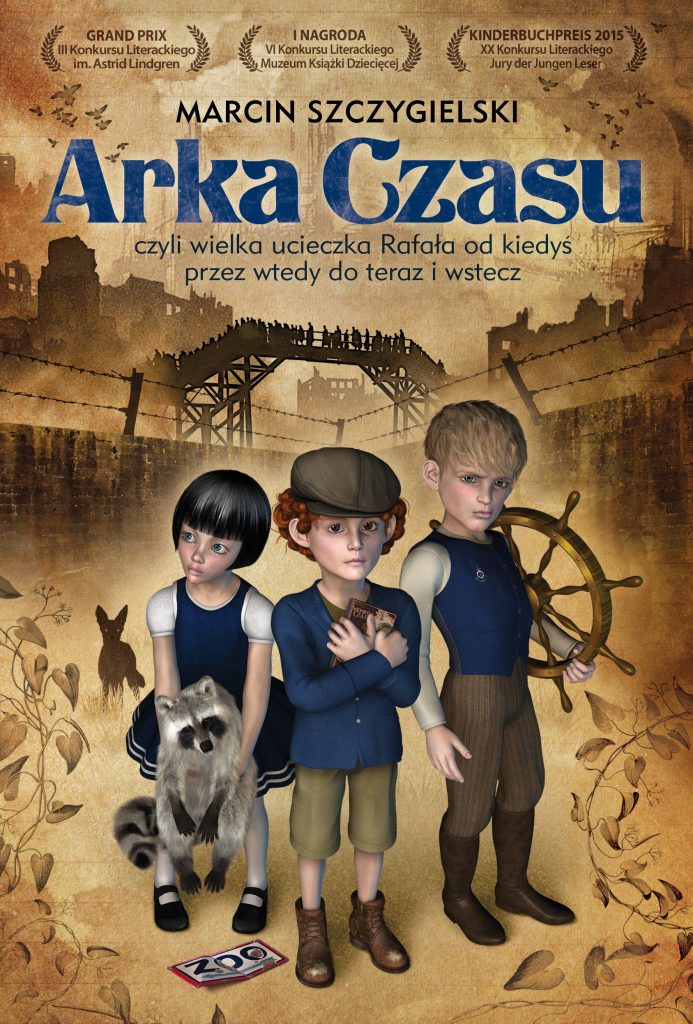Author: Marcin Szczygielski
Illustrator: Daniel de Latour
Year: 2013
Publisher: Wydawnictwo Piotra Marciszuka STENTOR
Place of publication: Warszawa
Pages: 288
ISBN: 9788363462154
Notes: Second edition with illustrations by the author: M. Szczygielski, Arka czasu, czyli wielka ucieczka Rafała od kiedyś przez wtedy do teraz i wstecz, Warszawa: Instytut Wydawniczy Latarnik, 2015, pp. 221, ISBN: 9788363841218
Translations:
- El arca del tiempo, trans. K. Olszewska Sonnenberg, Madrid: Báltica Editorial, pp. 255, ISBN: 9788494722714;
- Flügel aus Papier, trans. T. Weiler, Frankfurt am Main: Fischer Sauerländer Verlag, 2015, pp. 285, ISBN: 9783737352123;
- Ковчег времени или Большой побег Рафала из Когда-то в Сейчас через Тогда – и обратно, trans. А. Фруман, ill. С. Ухач, Москва: Текст, 2018, pp. 222, ISBN: 9785751614898;
- Ковчег часу або Велика втеча Рафала із колись крізь тоді в тепер і назад, trans. Б. Антоняк, Львів: Урбіно 2016, pp. 232, ISBN: 9789662647303.

Cover by Daniel de Latour courtesy of the publisher. ©Wydawnictwo Piotra Marciszuka STENTOR 
Cover by Marcin Szczygielski courtesy of the publisher. ©Creative Commons Attribution-Share Alike 4.0 International
Rafał’s favorite pastime is reading books, particularly adventure and fantastic stories. He lives with his grandfather in the Warsaw Ghetto. Despite the tragic realities surrounding him, Rafał visits the library regularly. One day, he reaches for H. G. Wells’ Time Machine (1895), the classic science fiction novel. In the tale of the conflict between cave-dwelling Morlocks and the oppressed Elois, Rafał sees an analogy to his own existence under German occupation, the everyday life in the Ghetto, and the time of the Holocaust. The word “KIEDYŚ” (in Polish meaning both “once” and “one day”) is repeated throughout The Ark of Time like a mantra. It is always written in capital letters. In Rafał’s perspective, it refers both to the past and the present, allowing him to compare the dreadful contemporaneity to what once was, but also to dream about a hopeful future. In the face of terror increasing in the Ghetto, Rafał’s grandfather pays for his smuggling to the so-called “Aryan” side, where the boy finds a hiding place in Warsaw’s zoological garden. At one point, he even gets into a Time Machine and is transported into the future, that is the year 2013 (when the novel was published). After a short sojourn, he returns to the time of the Second World War. However, the trip in time fills Rafał with the hope that a different future will come “ONE DAY”. When the area surrounding the zoo is stormed by the Germans, Rafał is transported to an elderly woman’s apartment where he survives the rest of the war.
The Ark of Time is distinguished by its combination of realistic and fantastic conventions (e.g. time travel). Notably, most of its plot is set on the “Aryan” side of Warsaw. Fragments of Szczygielski’s prose are inspired by surviving accounts of the Holocaust, Janusz Korczak’s writings, and the memoirs of Antonina Żabinska, who harbored Jews smuggled out of the Warsaw Ghetto in the Warsaw Zoo with her husband Jan, the Zoo’s director. Moreover, the author mentions a variety of locations in the Jewish quarter, often lesser known ones, which rarely appear in children’s literature. They include the Centos soup kitchen or the library at 67 Leszno Street, whose collections Rafał peruses (indeed, a lending library was located at that address as one of the twenty similar facilities in the Warsaw Ghetto). All this attests to the author’s meticulous research. In addition, the text was annotated and given a postface, entitled “Afterword, or what the first reader of the book wanted to know” (the original Polish refers to a female reader specifically), where Szczygielski reveals his inspirations and readings about the Holocaust as well as discusses events and people described in The Ark of Time.
Bibliography:
- Bolińska, M., Marcina Szczygielskiego spotkanie ze źródłem (Ludzie i zwierzęta Antoniny Żabińskiej), [in:] (Od)pamiętywanie – gry z przeszłością w literaturze dla dzieci i młodzieży, eds. B. Niesporek-Szamburska, M. Wójcik-Dudek, Katowice 2018, pp. 119–134;
- Ippoldt, L., Dziecko a wojna – literatura dla dzieci o tematyce wojennej na wybranych przykładach polsko- i niemieckojęzycznych, „Orbis Linguarum”, no. 48, 2018, pp. 501–504 (p. 503);
- Janus-Sitarz A., Gry wyobraźni a oswajanie przestrzeni strachu. Czasy Holokaustu w literaturze dla dzieci, [in:] Wolność i wyobraźnia w literaturze dziecięcej, eds. A. Czabanowska-Wróbel, M. Kotkowska, Kraków 2017, pp. 195–206;
- Jarzyna, A., Szlemiele. Zwierzęta wobec Zagłady w literaturze dla dzieci, „Narracje o Zagładzie”, no. 2, 2016, pp. 235–256;
- Jarzyna, A., Post-koiné. Studia o nieantropocentrycznych językach (poetyckich), Łódź 2019 (pp. 191–214);
- Jeziorkowska-Polakowska, A., „biała plamka na tle MURU to ja…” – angielski buldog opowiada o Zagładzie, [in:] (Nie)zapomniane zwierzęta, eds. E. Łoch, D. Piechota, A. Trześniewska-Nowak, Gdańsk 2021, pp. 129–161 (p. 132);
- Kania, A., Lekcja (nie)obecności. Dziedzictwo polsko-żydowskie w edukacji polonistycznej, Kraków 2017 (p. 94, 106);
- Karczewska, A., „Tylko czy niebo nadal istnieje?” Bóg w najnowszej dziecięcej literaturze o Zagładzie, [in:] Wiara i niewiara. Literackie realizacje wobec doświadczenia Zagłady, eds. P. Kalwiński, A. Karczewska, Lublin 2018, pp. 69–88;Karczewska, A., Pamięć i empatia. O dziecięcej literaturze Zagłady, [in:] Pamięć o Zagładzie w polskojęzycznej i niemieckojęzycznej literaturze autorek i autorów drugiego oraz trzeciego pokolenia post-Szoah / Das Gedächtnis an die Shoah in der polnischen und deutschsprachigen Literatur von Autorinnen und Autoren der zweiten und dritten Post-Shoah-Generation, eds. I. von der Lühe, S.J. Żurek, Lublin 2019, pp. 265–300;
- Kasperek, A., „Szlemiel” i „Arka czasu” jako przykłady współczesnej literatury dla dzieci poruszającej tematykę Zagłady, [in:] Zdeptane dzieciństwo. II wojna światowa i jej wpływ na sytuację dzieci, eds. A. Bartuś, P. Trojański, Oświęcim 2017, pp. 329–335;
- Kmiecik, I., Pamięć o Zagładzie w postmodernistycznej baśni – XY Joanny Rudniańskiej, [in:] (Od)pamiętywanie – gry z przeszłością w literaturze dla dzieci i młodzieży, eds. B. Niesporek-Szamburska, M. Wójcik-Dudek, Katowice 2018, pp. 135–146 (p. 135, 137);
- Kmiecik, I., Empatyzacja w powieści Arka czasu Marcina Szczygielskiego, [in:] Pamięć o Zagładzie w polskojęzycznej i niemieckojęzycznej literaturze autorek i autorów drugiego oraz trzeciego pokolenia post-Szoah / Das Gedächtnis an die Shoah in der polnischen und deutschsprachigen Literatur von Autorinnen und Autoren der zweiten und dritten Post-Shoah-Generation, eds. I. von der Lühe, S.J. Żurek, Lublin 2019, pp. 317–327;
- Kostecka, W., Once Upon a Time There Was a War: The Use of Fairy-tale Conventions in Contemporary Polish Literature for Children about Refugees, „Maska”, no. 36, 2017, pp. 33–49 (p. 33, fn. 2);
- Kowalska-Leder, J., Literatura polska ostatniego dziesięciolecia wobec Zagłady – próby odpowiedzi na nowe wyzwania, „Zagłada Żydów. Studia i materiały”, no. 10, 2014, pp. 768–802 (p. 789);
- Krajewska, A.M., Młodzieżowe książki o najnowszej historii Polski wydane w ostatnich latach – przegląd subiektywny, „Guliwer”, no. 3, 2018, pp. 69–76 (p. 73);
- Michułka, D., Przełamywanie granic książki dla dziecka. Ostatnie przedstawienie panny Esterki Adama Jaromira jako lektura o czytaniu pamięci, „Dydaktyka Polonistyczna”, no. 2 (11), 2016, pp. 98–107 (p. 99);
- Michułka, D., Gregorowicz, Ł., Czytanie pamięci – doświadczenie – emocje. Narracje literackie młodego czytelnika – teoria i praktyka odbioru (Rutka Joanny Fabickiej), „Polonistyka. Innowacje”, no. 7, 2018, pp. 41–58 (p. 45);
- Olszewska, B., Konwencja pamiętnika, dziennika, autobiografii w książkach o wojnie dla młodego czytelnika, [in:] (Od)pamiętywanie – gry z przeszłością w literaturze dla dzieci i młodzieży, eds. B. Niesporek-Szamburska, M. Wójcik-Dudek, Katowice 2018, pp. 101–117;
- Roszak, J., Czarne sezony. Czarne latawce. O dziecięcych bibliotekach w gettach, „Prace Filologiczne. Literaturoznawstwo”, no. 9 (12) part 2, 2019, pp. 231–244 (pp. 240–241);
- Rybak, K., „Grandma Zilbersztajn’s Christmas Bauble [Bombka babci Zilbersztajn]”, Our Mythical Childhood Survey;
- Rybak, K., Hide and Seek with Nazis. Playing with Child Identity in Polish Children’s Literature about the Shoah, „Libri & Liberi”, no. 6 (1), 2017, pp. 11–24;
- Rybak, K., Żyd i uchodźca. Znaczące powinowactwa narracyjne w polskiej literaturze dziecięcej ostatniej dekady, „Czy/tam/czy/tu. Literatura dziecięca i jej konteksty”, no. 2, 2017, pp. 44–62;
- Rybak, K., I (nie) żyli długo i szczęśliwie. Konstrukcje zakończeń w polskiej literaturze dziecięcej o Zagładzie, “Literatura Ludowa”, vol. 63, no. 1, 2019, pp. 10–23;
- Rybak, K., Dzieciństwo w labiryncie getta. Recepcja mitu labiryntu w polskiej literaturze dziecięcej o Zagładzie, Warszawa 2019;
- Rybak, K., Stosunki polsko-żydowskie i Zagłada w polskiej literaturze dziecięcej XXI wieku, [in:] Stosunki polsko-żydowskie, vol. 2, Kultura. Literatura, sztuka i nauka w XX wieku, ed. Z. Trębacz, Warszawa 2020, pp. 171–187;
- Rybak, K., Zagłada i ideologia w polskiej literaturze dziecięcej XXI wieku, „Narracje o Zagładzie”, no. 1(7), 2021, pp. 155–173 (p. 159, 163);
- Rybak, K., „Zupełnie inne miasto”. Obrazy warszawskiego getta w polskiej literaturze dziecięcej XXI wieku, „Dzieciństwo. Literatura i Kultura”, no. 3(1), 2021, pp. 67–84;
- Rybak, K., Obrazowanie Zagłady. Narracje holokaustowe w polskiej literaturze XXI wieku dla dzieci i młodzieży, Warszawa 2023;
- Sadowska, D., „Bajki-nie-bajki” czyli II wojna światowa w wybranych polsko- i niemieckojęzycznych utworach dla dzieci z ostatnich 15 lat ze szczególnym uwzględnieniem Asiuni Joanny Papuzińskiej, „Orbis Linguarum”, no. 48, 2018, pp. 169–187;
- Sałatarow, A., Trauma i pamięć w utworach Henryka Grynberga i Arce czasu Marcina Szczygielskiego, „Czy/tam/czy/tu. Literatura dziecięca i jej konteksty”, no. 1–2, 2020, pp. 34–47;
- Skowera, M., Polacy i Żydzi, dzieci i dorośli. Kto jest kim w Kotce Brygidy Joanny Rudniańskiej i Bezsenności Jutki Doroty Combrzyńskiej-Nogali, „Konteksty Kultury”, vol. 11, no. 1, 2014, pp. 57–72 (p. 59);
- Skowera, M., Różne odcienie dzieciństwa w utworze Agnieszki Suchowierskiej Mat i świat, „Litteraria Copernicana”, no. 3 (23), 2017, pp. 127–138 (p. 129, fn. 8);
- Skowera, M., „Jutka’s Insomnia [Bezsenność Jutki]”, Our Mythical Childhood Survey;
- Slany, K., Rutka Joanny Fabickiej jako przykład postpamięciowej literatury dla dzieci, „Maska”, no. 35, 2017, pp. 81–94 (p. 82);
- Szumal, M., Ada Judytka i zaginiony tałes. Dziecięcy klucz do wielokulturowego Białegostoku, „Polonistyka. Innowacje”, no. 9, 2019, pp. 131–140 (p. 133, fn. 7);
- Szumal, M., Między przeszłością a teraźniejszością. Literackie portrety prześladowanych w perspektywie dydaktyki polonistycznej, „Polonistyka. Innowacje”, no. 13, 2021, pp. 127–143;
- Tomczok, M., Anna Mach, Świadkowie świadectw. Postpamięć Zagłady w polskiej literaturze najnowszej; Małgorzata Wójcik-Dudek, W(y)czytać Zagładę. Praktyki postpamięci w polskiej literaturze XXI wieku dla dzieci i młodzieży, „Zagłada Żydów. Studia i materiały”, no. 13, 2017, pp. 795–801 (p. 800);
- Wójcik-Dudek, M., Dzieci i książki w Bibliotece Shoah, [w:] (Przed)szkolne spotkania z lekturą, eds. B. Niesporek-Szamburska, M. Wójcik-Dudek, in collaboration with A. Zok-Smoła, Katowice 2015, pp. 81–95;
- Wójcik-Dudek, M., Konieczność śladu. Kanony literatury dla dzieci i młodzieży, „Narracje o Zagładzie”, no. 1, 2015, pp. 96–116 (p. 105 fn. 27);
- Wójcik-Dudek, M., Między udziecinnieniem a infantylizacją Zagłady, [in:] Światy dzieciństwa. Infantylizacje w literaturze i kulturze, eds. M. Chrobak, K. Wądolny- Tatar, Kraków 2016, pp. 435–449 (p. 445, 447);
- Wójcik-Dudek, M., Matka – depozytariuszka sytości i głodu. Literatura dla dzieci i młodzieży wobec Zagłady, [in:] Kuchnia i stół w komunikacji społecznej. Tekst, dyskurs, kultura, eds. W. Żarski przy współpracy T. Piaseckiego, Wrocław 2016 pp. 449–458 (p. 453, 456 fn. 26);
- Wójcik-Dudek, M., Zamieszkać w Zagładzie. Geografia Holocaustu w literaturze dla dzieci i młodzieży, [in:] Geografia krain zmyślonych. Wokół kategorii miejsca i przestrzeni w literaturze dziecięcej, młodzieżowej i fantastycznej, eds. W. Kostecka, M. Skowera, Warszawa 2016, pp. 43–56;
- Wójcik-Dudek, M., W(y)czytać Zagładę. Praktyki postpamięci w polskiej literaturze XXI wieku dla dzieci i młodzieży, Katowice 2016;
- Wójcik-Dudek, M., Płynna postpamięć – motywy akwatyczne w literaturze osobnej podejmującej problematykę Holokaustu, [in:] Żywioły w literaturze dziecięcej. Woda, eds. A. Czabanowska-Wróbel, K. Zabawa, Kraków 2017, pp. 201–217;
- Wójcik-Dudek, M., „Efekt” Zagłady w polskiej współczesnej literaturze dla dzieci i młodzieży, [in:] Wiara i niewiara. Literackie realizacje wobec doświadczenia Zagłady, eds. P. Kalwiński, A. Karczewska, Lublin 2018, pp. 173–187 (p. 178);
- Wójcik-Dudek, M., Doświadczenie ziemi. Zagłada w najnowszej literaturze dla dzieci i młodzieży, [in:] Żywioły w literaturze dziecięcej. Ziemia, eds. A. Czabanowska-Wróbel, K. Zabawa, Kraków 2019, pp. 243–257 (pp. 250–255);
- Wójcik-Dudek, M., Memory Boom and Imaginarium of Holocaust in Polish Literature for Young Readers, „Filoteknos”, no. 10, 2020, pp. 309–323 (p. 320);
- Wróblewski, M., Doświadczanie dzieciństwa. Studium z antropologii literatury, Toruń 2019 (p. 181, 183–184).